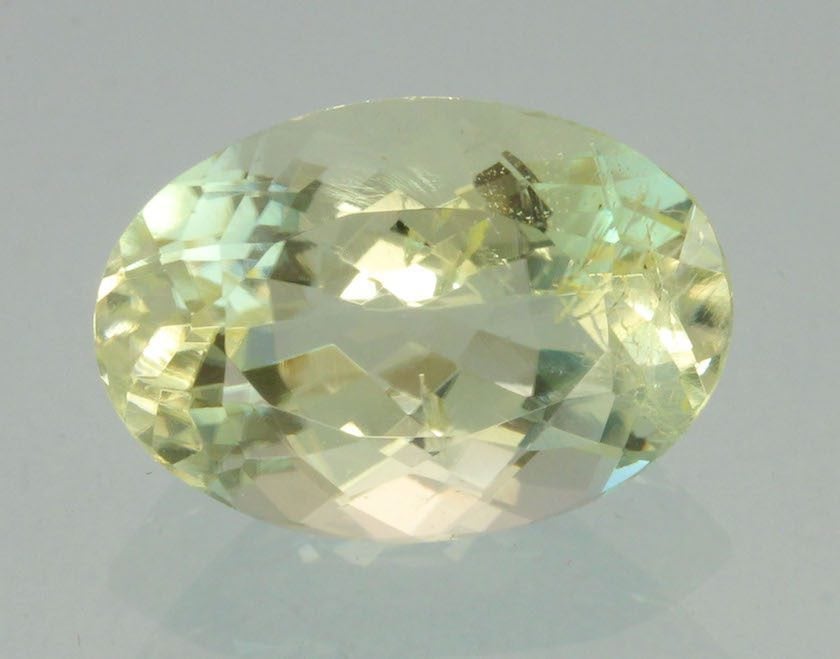Amblygonite Value, Price, and Jewelry Information
Amblygonite gems are usually pale straw yellow. Although they are too soft and cleavable to make good ring stones, collectors prize them if they show darker colors. Large faceted stones are extremely rare.
2 Minute Read
Amblygonite gems are usually pale straw yellow. Although they are too soft and cleavable to make good ring stones, collectors prize them if they show darker colors. Large faceted stones are extremely rare.
Start an IGS Membership today
for full access to our price guide (updated monthly).Amblygonite Value
Comments
Amblygonite and montebrasite form a mineral series. Fluorine-dominant (F) amblygonites are much rarer than hydroxyl-dominant (OH) montebrasites. In addition, amblygonite has a biaxial (-) optic sign, while montebrasite has a biaxial (+) optic sign. Many gems labelled as amblygonites in collections may merit reexamination.
Most yellow gems in this series, found in collections and on the market, are amblygonites from Brazil. However, stones from Mogi dãs Cruzes, Sao Paulo, Brazil, are montebrasite.
Extremely rare material from Karibib, Namibia shows a lilac color. These stones also make beautiful faceted gems.
Identifying Characteristics
| Species | Locality | α | β | γ | Birefringence | SG |
| Amblygonite | Chursdorf, Germany | 1.578 | - | 1.598 | 0.020 | 3.101 |
| Amblygonite | Uto, Sweden | 1.591 | 1.605 | 1.612 | 0.021 | 3.065 |
| Montebrasite | Karibib, Namibia | 1.594 | 1.608 | 1.616 | 0.022 | 3.085 |
| Montebrasite | Kimito, Finland | 1.611 | 1.619 | 1.633 | 0.022 | 3.00 |
| Natromontebrasite* | Fremont County, Colorado | 1.594 | 1.603 | 1.615 | 0.021 | 3.04 |
Note that refractive indices and optic angles decrease as sodium (Na) and F content increase. The change in optic sign (where 2V = 90°) occurs at around 60% (OH). A complete series of (OH, F) substitutions appears to exist.
* As of 2006, the International Mineralogical Association (IMA) no longer considers natromontebrasite a mineral species. Now, it's considered a mixture of amblygonite, lacroixite, and wardite. (See our article on gemological formulas for more information).
Synthetics
Using the hydrothermal method, scientists have synthesized amblygonites and montebrasites, as well as intermediate members of their series (Canadian Mineralogist, Vol 14, 357 pdf). However, jewelry use for such gems is unknown.
Enhancements
Pale yellow amblygonites may turn pale green with radiation treatment.
Sources
Custer County, South Dakota produces non gem-quality amblygonite masses up to 200 tons in size. Tinton, South Dakota also yields non-gem material in masses.
Most gem-quality amblygonites come from Brazil, where they occur in masses and crystals of fine, yellow color.
Other notable sources include:
- United States: Arizona; Pala, California; New Mexico;
- Germany; Sakangyi, Myanmar; Varutrask, Sweden.
Notable gem-quality montebrasite sources include Montebras, France and Karibib Namibia, as well as Brazil.
Other notable sources include:
- United States: Newry, Maine (in crystals greater than 3 x 4 inches in size, found in 1940-41, heavily included and provided only small gems); New Hampshire.
Stone Sizes
The largest cut amblygonite, cut from Brazilian material, weighs approximately 70 cts. Faceted gems normally range from 1 to 15 cts. However, cut gems very rarely top 10 cts.
- Smithsonian Institution (Washington, DC): 62.5 (yellow, Brazil), 19.7 (yellow, Myanmar).
- Royal Ontario Museum (Toronto, Ontario, Canada): 15.6.
- American Museum of Natural History, New York: 3 (colorless).
- Devonian Group (Calgary, Alberta, Canada): 47 (yellow, Brazil)
Care
Due to amblygonites' and montebrasites' relatively low hardness and perfect cleavage, avoid using mechanical cleaning methods like steam and ultrasonic. Instead, use a soft brush, mild detergent, and warm water. Consult our gemstone jewelry cleaning guide for more recommendations.
You'll more likely encounter these stones in mineral collections than jewelry collections. However, if you want jewelry made from these gems, use protective settings and avoid ring use. Pendants, brooches, and earrings shouldn't pose too many risks. Also, store this jewelry separately from more common, harder gem materials, like quartz, to avoid contact scratching.
Joel E. Arem, Ph.D., FGA
Dr. Joel E. Arem has more than 60 years of experience in the world of gems and minerals. After obtaining his Ph.D. in Mineralogy from Harvard University, he has published numerous books that are still among the most widely used references and guidebooks on crystals, gems and minerals in the world.
Co-founder and President of numerous organizations, Dr. Arem has enjoyed a lifelong career in mineralogy and gemology. He has been a Smithsonian scientist and Curator, a consultant to many well-known companies and institutions, and a prolific author and speaker. Although his main activities have been as a gem cutter and dealer, his focus has always been education. joelarem.com
International Gem Society
Related Articles
Faceting Tips for Exotic Gemstones
Black Diamond Value, Price, and Jewelry Information
Chameleon Diamond Value, Price, and Jewelry Information
Gray Diamond Value, Price, and Jewelry Information
Latest Articles
800 Years of Mogok: A Celebration in Tenuous Times
What is the Average Gemstone Faceting Yield?
Pyroxmangite Value, Price, and Jewelry Information
How to Identify Emerald Simulants and Synthetics
Never Stop Learning
When you join the IGS community, you get trusted diamond & gemstone information when you need it.
Get Gemology Insights
Get started with the International Gem Society’s free guide to gemstone identification. Join our weekly newsletter & get a free copy of the Gem ID Checklist!
